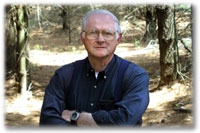Can you believe it? E-mails and even phone calls from those wanting to share with me the “proper” way to shock grain, the subject of last week's blog. Lots of memories associated with grain harvesting in yesteryear.
Someone asked me what happened after the grain was shocked. Threshing (separating the grain from the straw) came next, a highlight of the year for a farm kid. A threshing machine worked its way though the neighborhood, spending a day or more at each farm. All the neighbors helped with the threshing task, and for a kid, what fun it was. As an eight or nine year old, you shoveled the oats to the back of the oat bin. One task for three or four sturdy neighbors was to carry bag after bag of the freshly threshed oats from the threshing machine to the granary’s oat bins, so the shoveling job was never ending.
By the time you were twelve, you’d earned the dubious honor of sitting on the shaking and shuddering and very dusty threshing machine, working the handles and ropes to steer the straw blower so that a decent straw stack resulted. An important job, for a properly made straw stack would shed water.
By age 13, you graduated to spike pitching, meaning you helped load the oat bundles from the shocks onto horse-drawn wagons that toted the unthreshed grain to the threshing machine.
And if you did all of these previous jobs to satisfaction, by age 14 you moved up to the most glorious of all jobs, driving a team of horses on a bundle wagon and pitching off the load of bundles into the ever hungry maw of the machine. Anyone who could pitch off a load of bundles without missing a beat, and without plugging the threshing machine because you didn’t space the bundles properly had moved from childhood to manhood. A right of passage for a farm kid of my generation.
THE OLD TIMER SAYS: Remember when work was fun?
CHECK THIS OUT: CRANBERRY RED is appearing in the bookstores. Learn all about cranberry growing, county agent work, and what happens when research goes amuck. UW Press is the publisher of this, my fourth novel, in the Ames County series.
WRITING WORKSHOPS:
Saturday, October 30. There is still room in my day-long workshop. Contact: The Clearing Folk School www.theclearing.org P.O. Box 65 | 12171 Garrett Bay Road | Ellison Bay, Wisconsin 54210 Toll Free: 877.854.3225 | clearing@theclearing.org Monday - Friday 8-4
UPCOMING EVENTS:
August 6-10, Research trip, Boundary Waters Canoe Area, Northern Minnesota.
September 13, 10:00 a.m., Attic Angels Retirement Center, Madison. Horse Drawn Days.
September 14, noon, Waupaca Library, Waupaca, WI. Ames County Novels.
September 18-19, Creekside Books, Cedarburg, WI. Barns and Horse Drawn Days.
September 21, 7:00 p.m., Barnes and Noble, Madison, Launch of Cranberry Red.
Sunday, August 29, 2010
Subscribe to:
Post Comments (Atom)

1 comment:
I am not from a farm background but came to farming by another route.
One thing that has always confused me about thrashing is that the center mow floor in barns is referred to as the "thrash floor".
This is the reinforced section in the middle where we always pulled hay wagons into with the tractor for easy unloading until the stack got too high.
Even when I ask some older farmers they cant really answer my question about how it got that name and how it might have been used for thrashing.
All the pictures and demonstrations I have ever seen have been with the thresher outside in the open blowing the straw onto a pile.
A good discussion about how this term came to be and how the barns were used when first built would be very interesting!
Post a Comment